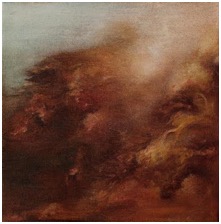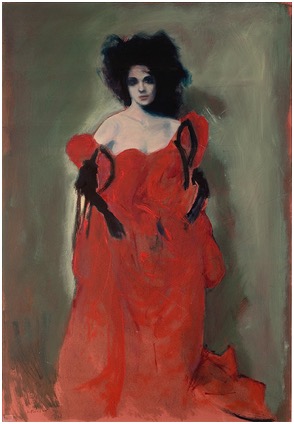Copal 2 & 3
Copal 2 (improv) by leahkardos
Copal 3 is a sentimental little piano piece that I played shortly after learning that a childhood pet had finally died. Claudia was my little Burmese cat, such a delicate soft little thing. She would sit on top of my piano while I practiced as a youngster... so a little bit of simple child-like piano music seems appropriate in the moment. Aww rest in peace sweet kitty cat.
Copal 3 (improv/Claudia's Song) by leahkardos
Right. That's enough improv for now, I think. There's a lot of proper writing I need to be getting on with.
-----
Feather Hammer
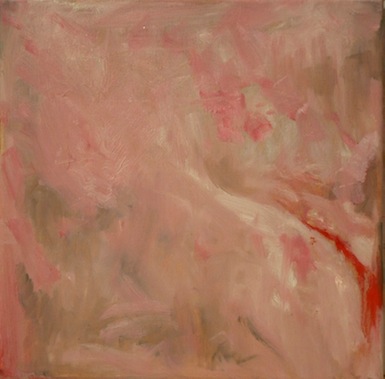
The Feather Hammer is an ambient piano record I have just finished writing and am about to commence production on. The artwork to the left will be the cover, a wonderful piece by Kristian Purcell called "Unelma 1".
The record will comprise of piano sounds - played music and ambient sounds recorded "around" the music (a longer more detailed blog on this aspect will probably come soon) - and location recordings taken from around Bedford, mostly the college campus where I work.
Strongly inspired by Bjork's Vespertine, with its percussion tracks utilising soft intimate non-musical sounds (shuffling cards, clinking cutlery, footsteps through snow), and Amon Tobin's Foley Room where textures of found sounds are built up to create heavy, thick ambiences. Other influences come from the Harold Budd/Eno collaborations and Aphex Twin's Selected Ambient Works. The focus will be on combining and manipulating recorded audio, avoiding synthesis and most digital effects.
At the centre of the production is a collection of 9 solo piano compositions that have been traditionally scored and performed by me. I am quite excited about this project as it is the first where I really get to try out all my fancy PhD process ideas and experiment with production concepts gleaned from psychoacoustic research. It's an extra treat that I get to perform on my favourite instrument. Due to me not being able to say no to anyone or anything, it's been on the back burner for a while... but this is where my heart is at the moment, it's all I want to work on. I don't want to say I'll have it done in early 2011, since I have a pile of commitments bearing down on me over the holiday season. As progress is made I will update the blog with news, ideas and demos but for now... isn't the cover just lovely?
-----
Kristian Purcell
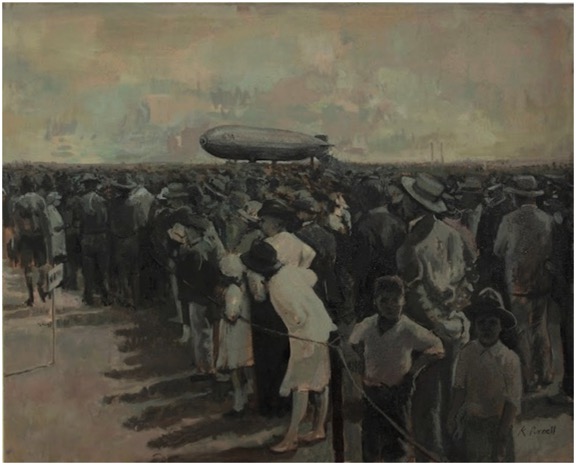
R34 at Mineola, NY, 1919, 2010 (Oil on canvas, 61x76cm)
click the images below to get info
Sometimes, when someone tells me they make art, I might expect the stuff they make will be "Ok...". Maybe it's just me and my pessimistic outlook on life, but I often have low expectations when it comes to these things (it's a good way to be, since most of the time I'm pleasantly surprised, which is a nice reaction, right?). These arty people show you their latest thing and you're all "Oh wow, that's great!" but in your head you're not really thinking it's truly great art, only that its great that they are pursuing creative endeavours in general. I've been in bands and struggling to have my music heard for years - some of it not very good at all - so I know what it feels like to be humoured by your mates. And of course you're grateful for it, that's what your mates are there for. We all need encouragement.
But then there are people that come into your life who are so good that they knock you on your arse, and you can't believe they are working day-jobs in Bedford and not being shown at the Tate. A person who forces you to recalibrate your scale of superlatives (that handmade coffee cup you liked on Facebook is suddenly not so literally "awesome", for example). Kristian Purcell is such a person. A proper artist. I also have the honour of calling him my friend.
I met Kristian rather unglamourously, as a result of trolling Myspace for potential musical collaborators. This was back in 2007 when Myspace was still sort of happening, but also sort of starting to shrivel and die. He lived in Bedford, he liked Bowie, he could sing and play guitar. That was enough for us (well, enough for me - I'm sure Matt would prefer the Bowie connection didn't exist, since he has had to endure both of us drunkenly screeching our way through "Teenage Wildlife" at least a dozen times to date. I don't think he finds it amusing, which is a shame since I'll probably be inclined to do this as often as I'm drunk on red wine for the rest of my life). He joined the band, we gigged a little bit, wrote some music together and made a record in the spare room of my house. He worked various day jobs, teaching contracts and working at the Cecil Higgins Art Gallery & Bedford Museum; he wasn't famous or critically lauded or making any money from his wonderful art and it didn't seem right.
I remember when he transformed the Wellington Street house he was living in at the time into a makeshift gallery and invited the town to see (and possibly buy) his work. It was a genius bit of initiative, and Matt and I both felt like arseholes for trying to haggle down the prices of the two small pieces we ended up buying that night. Mates rates? C'mon we're all struggling artists here... I also remember sitting with Kristian in the Gordon Arms a few days after Xmas 2008, having a deep discussion about music and art and what the hell we were doing with our lives. We're both the same age, and we share the same frustrations that stem from being unknown, from dealing with universal apathy on a daily basis, the fears that we might have missed our opportunity to be successful. During the course of that conversation we discussed studying our disciplines again and maybe I should take the plunge with the PhD. Within months that wishful drunken chatter had become a reality for me, a decision that (I feel) has put me on the right track with my career.
Kristian deserves success because his art is great. And it's getting better. If you're reading this and you're not familiar with his work, you need to check it out immediately. If you have the means to, invest in one of his pieces now - they're bound to be worth stupid amounts of money one day (chat to him, he might be able to do "mate's rates"). Comment on his blog, because god knows we all need a bit of encouragement.
And the musical collaboration continues, sort of. There are wishy-washy plans to record new material with the band in the new year, but a far more concrete prospect is a gig we'll be playing together at Bedford Esquires on the 20th of November (this Saturday night). It's more a Kristian Purcell solo gig with me accompanying on piano. I think we're even doing a couple of Helzuki songs from that record we made in my spare room in 2008. Should be fun to bust out the furry red stage piano once again, it's been too long.
___________________
UPDATE: GIg has been and gone, and here's a review
Black Mouth of August - II Dance Movement (excerpt)
-----
"My first recycling experiment" or "how I hacked up Rob Davidson's String Quartet beyond recognition"
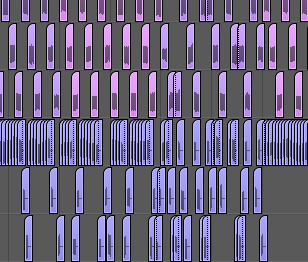
(What I'm talking about is the subject of that last blog of mine - this whole idea of a composition evolving, the recorded artefact becoming the starting point for a new creation.)
So I decided to experiment, to find out how easy it is to chop and manipulate an existing recording in order to create something completely different. My string quartet is not finished, so I stole Rob Davidson's String Quartet - a live recording that had some really interesting room ambience in the mix, and some fun audience sounds (coughing, sneezing, etc).
Here's an excerpt from Rob's recording (the opening):
String Quartet - Rob Davdison (Opening/Example) by LeahExperiments
The following experiments/hack jobs were made purely by recycling bits of the above recording, with bits mostly taken from the first movement. In Logic, I used EQ, scissor, time-stretch, reverse, reverb & flex tools to completely mess it up.
Experiment 1:
Experiment 1 (recycling String Quartet by Rob Davidson) by LeahExperiments
Experiment 2:
Experiment 2 (recycling String Quartet by Rob Davidson) by LeahExperiments
I'm not sure if the results are good enough to play at the seminar, but I think they are interesting all the same. There are some peculiar dissonances that I wasn't expecting, which resulted from combining notes and chords taken from different places where tunings had slightly shifted in the performance. In some places this is pleasing, in others it definitely grates! When I took a short sample and stretched it a long way it produced a rustling guitar-like effect, which I thought was a happy accident. The limitations in my examples are clear with regard to melody/harmony/tonality - this was partly due to the fact that I chose to focus on a short section of the recording to plunder for samples, but mostly due to me being lazy and opting for drone-based harmony layers and glitchy rhythms.
-----
Evolution (and life after death) for my String Quartet
I’ve been working on this thing on and off for many months now - and I take heart in knowing that Maurice Ravel, whose Quartet in F major is an aspirational model for me with this project, himself took a long time too. Ariella commissioned it back in January 2009, I suspect they think I’ve forgotten about it completely.
The music is pretty much there, the hold up has been in the details - the attention to voice leading, the dynamics, the interior lines. After a spell of being all “Rah, time to get this bitch DONE and DUSTED”, throwing all my notes at the score with a 'that’ll do’ attitude, I’m now actually really enjoying giving it some careful attention. I think it deserves some, and I’m learning so much from the process. An hour spent inside the first movement getting a couple of cadences right, its fun .... not unlike sudoku.
Another aspect that I have been in two minds about has been the final format of the piece. Not wanting to shoehorn technology into it in a desperate bid to make the piece ‘modern’ or to fit in with my PhD research, but at the same time wanting to use the material for experimentation in some way without diminishing the musicality and appeal of the finished work. Then I hit on the solution - recycling! The score that becomes a performance that becomes a recording, and then a recording that becomes fodder for manipulation and restructuring (chopping, splicing, juxtaposing, sampling) that then becomes something completely new.
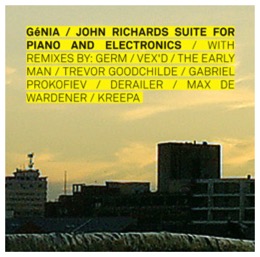
Then there’s my beloved Aphex Twin and his 26 remixes for cash in which, along with many weird and wonderful things, he gives us a re-imagining of Gavin Bryars’ ‘Sinking of the Titanic’ (he calls it “Raising the Titanic” ) and an eerie mash-up of Philip Glass’ Heroes symphony with the original David Bowie acapella vocal take from 1977. I have always regarded this guy to be a serious composer of new music - I defy anyone who’s actually listened to “drukQs” and his “Selected Ambient Works” to tell me I’m wrong.
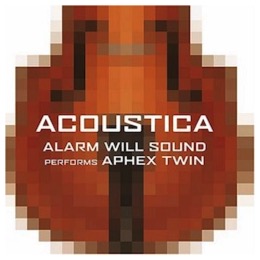
I was talking to Rob (my PhD supervisor) recently about the chamber ensemble “Alarm Will Sound’, a group that somehow has the audacious bollocks to attempt to play Aphex Twin’s music live with real instruments. Something people thought was impossible, but they did it! With kettle drums and bassoons! What strikes you when you hear their renditions is how rare the music sounds - no-one would ever compose this stuff from a score, putting notes on a page. It’s a completely different way of composition - made possible by technology - where timbre and texture are king.
In Daniel Levetin’s awesome book “Your Brain on Music”, he reminds us that distinguishing timbre is one of the most sophisticated and important parts of our hearing:
... it is the most important and ecologically relevant feature of auditory events. The timbre of a sound is the principal feature that distinguishes the growl of a lion from the purr of a cat, the crack of thunder from the crash of ocean waves, the voice of a friend from that of a bill collector one is trying to dodge. Timbral discrimination is so acute in humans that most of us can recognize hundreds of different voices. We can even tell whether someone close to us - our mother, our spouse - is happy or sad, healthy or coming down with a cold. ... I believe timbre is at the centre of our appreciation of music”
Traditionally, this aspect was a bit of an unknown to composers who wrote scores. Even though most of us expect violins to have certain timbral qualities, the small differences in sound brought about by various instrument builds, performance idiosyncrasies, effects of spaces on ambience & standing waves, tunings etc are impossible to know. When material is recorded however, then these aspects are known from the outset and very much in the composers control.
I think people are really tuned in to the qualities of sound these days - there’s much talk about the timbral qualities of valve/analogue equipment, the superior listening experience provided by phonograph records or digital audio (depending which side of the fence you sit on) or whatever bit compression your mp3 happens to be to what dithering algorithm you bounce your masters with. Even people who aren’t musicians will comment on a “fat” bass line, a ‘dirty’ synth, a ‘heavy’ guitar part. Beethoven sounds better when played on a Bösendorfer than through a General MIDI module. I’m told that Haydn sounds perfect in the Esterhazy hall.
But back to the quartet... this is where I’m at with it right now - finishing the score, giving my attention to perfecting form, harmony, melodic themes, and all the other details. Once that is done, I eagerly anticipate hearing how Ariella play it, and recording the performance. Then to take that recorded performance apart and build something new with it.
*******************
UPDATE:
Is it wrong that Sibleius' 'REPRISE' music font on my music gives me the horn? (click --->1 score (08-05-10))
-----
